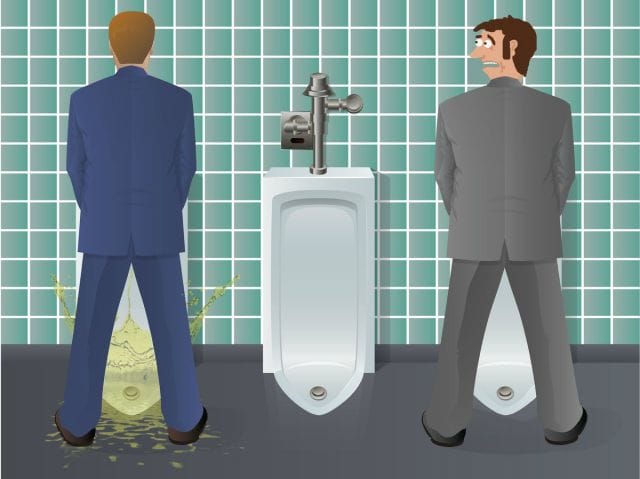
If you use a urinal or stand when you use the toilet, pee splashes back on you.
If you share a bathroom with someone who stands when he pees, a fine layer of pee covers your bathroom floor.
If you’ve used a urinal at the same time as someone standing next to you, his pee has splashed on you.
When men urinate standing up, pee ricochets off the porcelain beyond the toilet or urinal. This may come as news to you, but interior designer Debbie Wiener is familiar with this “splashback” problem.
“It’s a constant problem between men and women,” she says, and one that comes up frequently when she works with clients to redo their bathrooms. Women want a way to keep the toilet and bathroom floor free of splashing urine, and so does Mrs. Wiener. “I can’t walk into my bathroom barefoot!” she exclaims.
Debbie Wiener is a veteran of the interior design business, but she doesn’t know of a splash-proof toilet to recommend to her clients. “If there was one, I would consider buying it,” she says. “I’ve never seen such a thing in the trade magazines.”
Instead she recommends the same solution she has settled on in her home: towels. She keeps a drawer full of big, bleachable towels, and every day she puts a fresh one on the floor in front of the toilet. She has no solution to keep pee from splashing on men’s pants.
The flush toilet became a mass market product over 150 years ago. So why haven’t we designed one that doesn’t splash?
The Physics of Peeing
If you want to avoid splashing pee on your pants, you should stand closer to the urinal.
This is the counterintuitive finding of 4 physicists at Brigham Young University’s Splash Lab, which has published work on how schools of fish move in perfect coordination and the physics of skipping stones across a pond. In 2013, these four “wizz kids” used their understanding of fluid mechanics to study splashback.
If you don’t think splashback is a problem, or if you are a woman feeling mystified and alarmed by this article, wizz kid Tadd Truscott, a professor of Mechanical Engineering at BYU, has bad news for you.
“In the absence of dividers between urinals, it would not be unlikely for urine droplets to travel a distance of 5 feet to the side of the urinator,” Dr. Truscott tells us in an email. “And if someone were standing next to him, they would most definitely get small droplets OF THE OTHER MAN’S URINE on their pants and shoes.”
Truscott says he is working to measure exactly how much urine splashes when men pee standing up. But he is certain that the problem exists with both urinals and toilets. “We do know that a male of average height urinating into a traditional toilet while standing,” he writes, “will launch small droplets out of the toilet and onto the floor, cupboards, and shower curtain.”
“I have seen splatter marks nearly at eye level. No joke.”
Truscott says the idea came to him and his fellow researchers the same way it crops up in every man’s life: when using a urinal while wearing khaki pants. Inspired by the inevitable stains on their pants, they built pee simulators out of thin nozzles that sprayed water into buckets of water or against hard surfaces.
They filmed each simulation with high speed cameras, and as they watched the splash in glorious, high-definition, slow motion, they reached several conclusions.
The first is that it’s better to stand close to the urinal. As fluids stream through the air, they break into droplets—the technical term for this is Plateau-Rayleigh instability—and droplets of urine splash more than a stream of urine. This sounds counterintuitive, but you experience the soundness of this suggestion every time you sit on a toilet seat just inches from the water.

Videos via the Splash Lab
The BYU team also learned that a “low angle of attack” produces the least splash. When pee hits the porcelain at a 90 degree angle, the splashback is terrible. But when the urine simulator aimed low—imagine hitting just above the drain of the urinal—the splash was more modest and not angled back at the urinator. This is also a good reason to aim sideways rather than straight at the urinal.
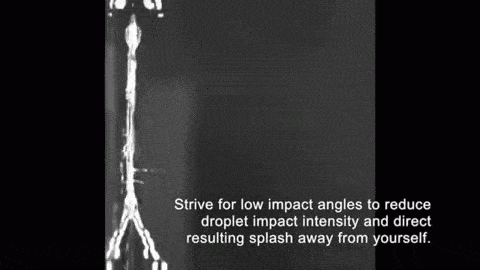
Their findings garnered more attention than the average fluid mechanics paper. The researchers presented their work at conferences, the BBC profiled their research, and Seth Meyers joked about their work on Saturday Night Live:
“Researchers at Brigham Young University are studying ways to prevent urine splashback when men use the toilet. ‘Hurry up!’ said men in khakis.”
For a brief period, Truscott and the other researchers were the biggest thing in the world of toilets, advising men how best to pee to avoid splashback.
But why did we need their advice in the first place? Why aren’t toilets and urinals designed to prevent this?
An Old Problem
Our search for answers led us to Duravit, one of the world’s largest suppliers of bathroom fixtures. We contacted their team of toilet designers, who are based in Germany. It felt like they inhabited a different universe.
“It is something we mitigated years ago,” they told us over email, in response to a question about reducing the splash made by toilets and urinals. “To us, this is a story of the past.”
As far as Duravit’s toilet designers are concerned, splashback does not exist. It’s a problem they fixed long ago, and they test each toilet and urinal and allow “a maximum of three splashes of water 2 mm in size within a radius of 20 cm.” Nothing to see here; move along. Now they’re focused on making toilets that use less water or have a more hygienic glaze.
They only gave one hint that splash might be a concern: they make urinals with an optional “target fly.” If men aim for the fly, which is a bug painted on the urinal at the best spot to aim for, it reduces splash by 70%.
The toilet designers’ claim—that they don’t see splashback as a problem—was not a language error. Their meaning was not lost in translation.
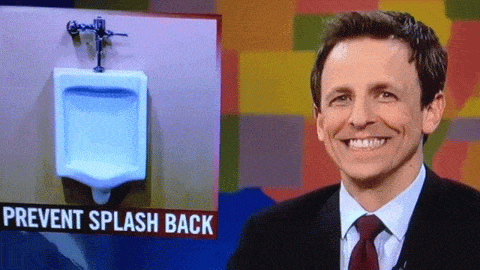
We next spoke to Tim Schroeder, president of Duravit’s U.S. division. He immediately told us, “You really just don’t get splash from modern toilets.”
Schroeder did not sound like an executive denying a problem. He sounded baffled. “It’s not a complaint that we’ve seen in the marketplace since 20 years ago when we reduced the water surface area in toilets,” he says of the splashing problem. Schroeder described how both Duravit and its competitors exceed plumbing code standards about splash. “This is an odd discussion for us,” he adds. “It’s not that we’re not interested, but we don’t hear this feedback.”
“I’ve just not had this conversation, and I’ve been with the company for 25 years.”
With some pressing, Schroeder acknowledged that people might need to search for that sweet spot—the best spot to aim at, like the one indicated by Duravit’s target fly. But he calls splash “human error.”
“It’s like washing your hands in the sink. I could make a big mess, but I don’t. I’m careful.”
As for the idea that splashback from toilets and urinals consistently stains men’s pants, covers bathroom floors, and leads to endless arguments between husbands and wives? That one of his products is so problematic that researchers like Dr. Truscott advise people to aim from the side or cover the toilet water with a layer of toilet paper?
He simply could not believe it.
The Toilet Taboo
The splashback problem is not the only ongoing mystery in the world of bathroom design.
In 2012, Priceonomics reported on the struggle to introduce Japanese toilets in America. The toilets have features like heated seats and a bidet function—the ability to clean your derriere with water—and they are ubiquitous in Japan and nicer than any toilet you’ll find in an American billionaire’s house. (If you’re skeptical, ask yourself which you’d want if a turd landed on your arm: paper or water?)
The toilets get rave reviews from converts, but they remain largely unknown. In the same way that splashing toilets and urinals have persisted, Americans keep using an inferior technology: toilet paper.
According to Steve Scheer, president of a startup struggling to sell Japanese-style toilets in America, a major obstacle is Americans’ reluctance to discuss bathroom issues. “You wouldn’t imagine how many people giggle nervously or say ‘gross’ when we try to educate them about the advantages of the bidet seat,” he says.
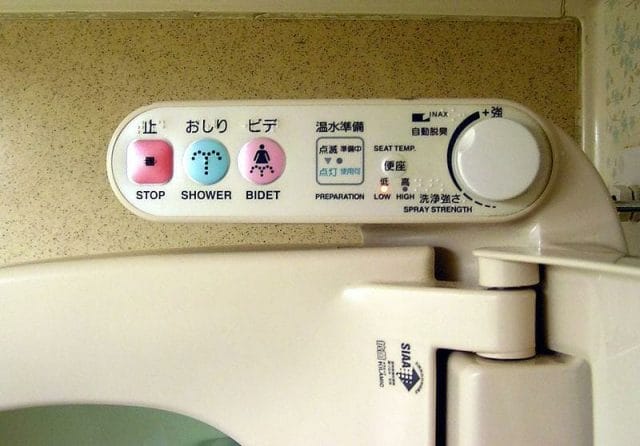
Photo by Armin Kubelbeck, CC-BY-SA, Wikimedia Commons
This same problem—that talking about toilets is taboo—plays the villain in a Freakonomics podcast that investigates a related mystery: Why don’t we play music in public restrooms?
As Freakonomics host Stephen Dubner relates, designers and architects carefully consider sound when they design public spaces. It’s why lounges play slow music that influences people to linger and buy more drinks, why experts don’t recommend open office plans, and why elevator music developed as a way to make standing in a tiny, moving room seem more natural. Yet in restrooms, we’re left in silence to listen to each other’s bowel movements. Some people are so mortified that they won’t poop until someone flushes and masks the sound.
Harvey Molotch, an NYU professor and author of Toilet: Public Restrooms and the Politics of Sharing, tells Dubner that the toilet taboo disrupts the normal feedback loop between customer criticism and better design.
“Where there’s a taboo and you can’t speak freely about something, it becomes a place where there’s not accountability,” Molotch says. “With the iPhone, we can question, ‘How come it’s like this? Wouldn’t it be better like this or that?’ You can’t really [give feedback about] a toilet.”
Based on his experience working on building committees, Molotch adds:
“Even working with the most prominent architects of the world, never is there discussion about the substance of the toilet stalls. And, as a result, you get the lowest person typically on the totem pole of the architectural firm is given that job. And then they sort of call up the mass supplier, and they just order the same stuff.”
When we contacted Molotch about the splashback problem, he saw the same culture at work. “We have never been able, as a society, to put some real resources into the design of such things,” he told us. “Again, it’s the taboo which means it would be hard to bring up [toilets] at executive meetings among those who run buildings.”

In our conversation with Tim Schroeder, he and Duravit did not sound stifled by taboo. He described the “pre-testing and deep discussions about performance and maintenance” that take place when developing new products like a waterless urinal. He talked about working closely with customers like large hotel chains and speaking with a customer whose toilet splashed due to an overly powerful flush—the only feedback, Schroeder says, he has ever received about splashing. The toilet design team mentioned focus groups.
It seems crazy that Duravit employees could spend 40-hour weeks talking about toilets without discussing splashback or soliciting complaints. Yet the power of the toilet taboo is equally crazy.
Even in our modern age of raunchy standup routines, our silence about bathroom habits results in incredible ignorance. In a legendary Reddit post, one man confessed that he realized he had misinterpreted comments about men “putting the seat up.” For his entire life, he had been sitting on the rim of the toilet when he pooped.
In the comments section, someone wrote, “My mom told me all the ladies in her office catch the poop with a TP covered hand and gently lower it into the water to guarantee there is no embarrassing plop noise.”
We can’t tell you if that’s true, and neither can anyone else, because no one talks about bathroom habits. Go ask your friends if they pee in the shower and see what happens. Or ask whether it’s “normal” to sit or stand while wiping, hover over public toilet seats, or meet a man who always sits down to pee.
When we broached the topic of splashback in the office, one Priceonomics writer exclaimed, “I thought it was just me!”
We’re still baffled by Duravit’s reaction to our questions about splashback. Some men we’ve talked to say splash is not a problem. Maybe they have superior peeing form, or maybe they are even a majority. We suspect most of them have just not worn khakis in awhile.
But as far as we can tell, the toilet taboo is keeping us in an age of splashing urinals and toilets.
Would a Duravit executive hear about splashback for the first time from a journalist if Duravit designers observed (with some precautions) people using toilets the same way designers watch people use prototypes of their apps?
In a less restrained culture, wouldn’t focus groups immediately bring up splashback and how gross it is to clean urine of the rim of the toilet?
Not every toilet manufacturer claims that splashback is not a problem. In 2006, Kohler, which did not respond to our interview requests, unveiled its Steward urinal. Industry press coverage noted that Kohler had “identified splash as the biggest problem with today’s urinals,” and the product announcement claimed that the urinal “virtually eliminates splash-back.”
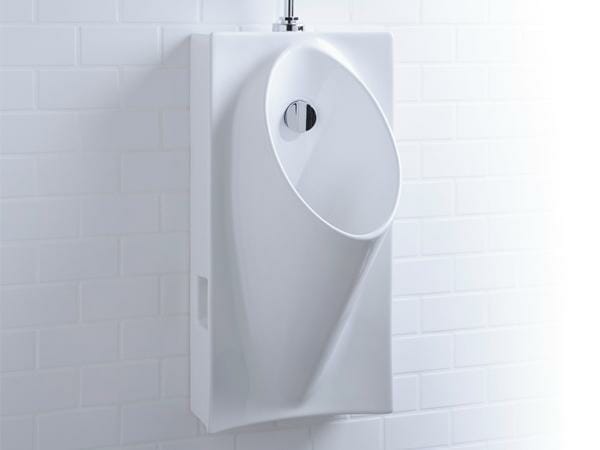
The Steward urinal; photo via Kohler
In a sane world, Kohler would have shouted from the mountaintops that its urinal would end the splashback problem and liberate us from urine stains. Instead Kohler touted how its waterless flush would save water, and it mentioned, almost in passing, how the urinal “also” prevented splashback.
The only way to end this madness is to break the toilet taboo. If we want to live in a world free of flying urine and bring peace to bickering couples and roommates, we need to complain about toilets the same way we vent about iPhones and Starbucks coffee cups. We need to tweet @duravit and @kohler to tell them we desperately want a no-splash toilet. And we need to acknowledge splashback and figure out how to prevent it.
Or men could all just sit down.
![]()
This post was written by Alex Mayyasi. You can follow him on Twitter at @amayyasi. An earlier version of this post first appeared on November 23, 2015.



